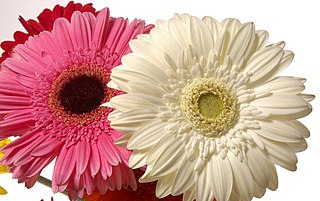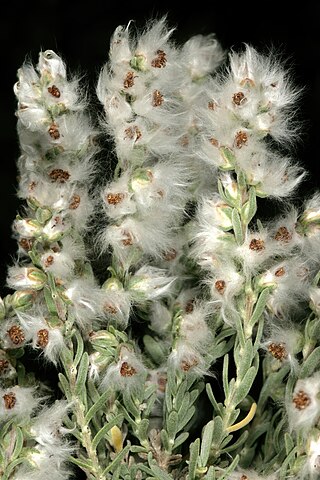
Osteospermum, is a genus of flowering plants belonging to the Calenduleae, one of the smaller tribes of the sunflower/daisy family Asteraceae. They are known as the daisybushes or African daisies. Its species have been given several common names, including African daisy, South African daisy, Cape daisy and blue-eyed daisy.

Matricaria is a genus of flowering plants in the chamomile tribe within the sunflower family. Some of the species have the common name of "mayweed", but this name also refers to plants not in this genus.

Symphyotrichum novae-angliae is a species of flowering plant in the aster family (Asteraceae) native to central and eastern North America. Commonly known as New England aster, hairy Michaelmas-daisy, or Michaelmas daisy, it is a perennial, herbaceous plant usually between 30 and 120 centimeters tall and 60 to 90 cm wide.

Gerbera L. is a genus of plants in the Asteraceae (Compositae) family. The first scientific description of a Gerbera was made by J. D. Hooker in Curtis's Botanical Magazine in 1889 when he described Gerbera jamesonii, a South African species also known as Transvaal daisy or Barberton daisy. Gerbera is also commonly known as the African daisy.

Cineraria is a genus of flowering plants in the sunflower family, native primarily to southern Africa with a few species farther north. The genus includes herbaceous plants and small subshrubs.

Inula is a genus of about 80 species of flowering plants in the family Asteraceae, native to Europe, Asia and Africa.

Macaranga is a large genus of Old World tropical trees of the family Euphorbiaceae and the only genus in the subtribe Macaranginae. Native to Africa, Australasia, Asia and various islands of the Indian and Pacific Oceans, the genus comprises over 300 different species. It was first described as a genus in 1806, based on specimens collected on the Island of Mauritius.

Heliophila is a genus of flowering plants in the family Brassicaceae. Members of this genus are either annuals or perennials and some are popular as ornamental plants. Endemic to southern Africa, the majority of the approximately 80 species grow in South Africa, particularly the Cape Floristic Region, while a few extend into the Namib Desert.

Eriocephalus africanus is a bushy shrublet indigenous to South Africa. It has a wide distribution in the Western and Eastern Cape, and in Namaqualand. The plant has several common names in various languages. It is known as the Kapokbossie or Wild Rosemary referring to its fancied resemblance to rosemary. The superficial resemblance is in the foliage, which, though softer and not glossy, grows in a habit similar to that of the common Mediterranean rosemary, although the two species are not related.

Cotula is a genus of flowering plant in the sunflower family. It includes plants known generally as water buttons or buttonweeds.

Filago is a genus of plants in the sunflower family, native from Europe and northern Africa to Mongolia, Nepal, and Macaronesia. They are sometimes called cottonroses or cudweeds.

Garuleum is a genus of flowering plants in the sunflower family, native to southern Africa. Garuleum is one of eight genera of Calenduleae.

Elephantopus is a genus of perennial plants in the daisy family (Asteraceae).

Chrysocoma is a genus of flowering plants in the family Asteraceae, native to Africa and Australia.
Nolletia is a genus of flowering plants in the tribe Astereae within the family Asteraceae. The genus was named in honour of Jean-Antoine Nollet, French clergyman and physicist.
Otostegia integrifolia, more commonly known as Abyssinian rose, a plant belonging to the family Lamiaceae, is endemic to Ethiopia, in the dry evergreen woodlands of the Bale Mountains, Tigray, Gondar, Wollo and Gojjam regions, North Shewa, Kaffa and Hararghe regions, as well as in the dry and moist agroclimatic zones of the district known as Dega, at altitudes of 1,300—2,800 m. above sea-level. It also grows in Yemen, northwest of Mukalla. In Ethiopia, O. integrifolia is commonly known by its Amharic vernacular of tinjute = ጥንጁት.

Eriocephalus racemosus is a species of flowering plant in the genus Eriocephalus. It is endemic to the Cape Provinces of South Africa. It is also called the kapokbos.


















